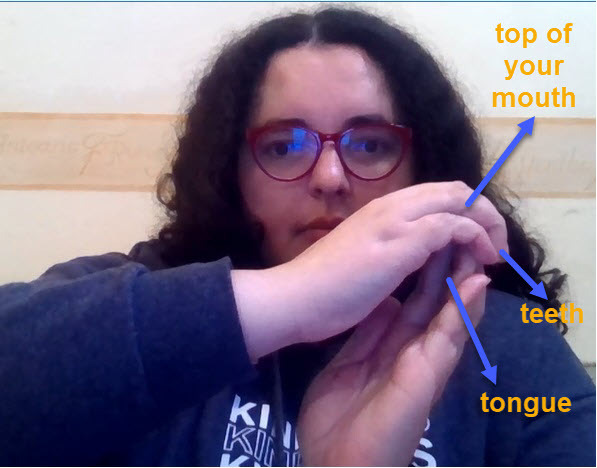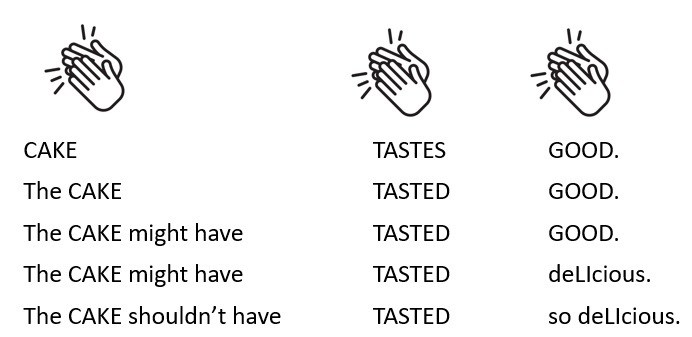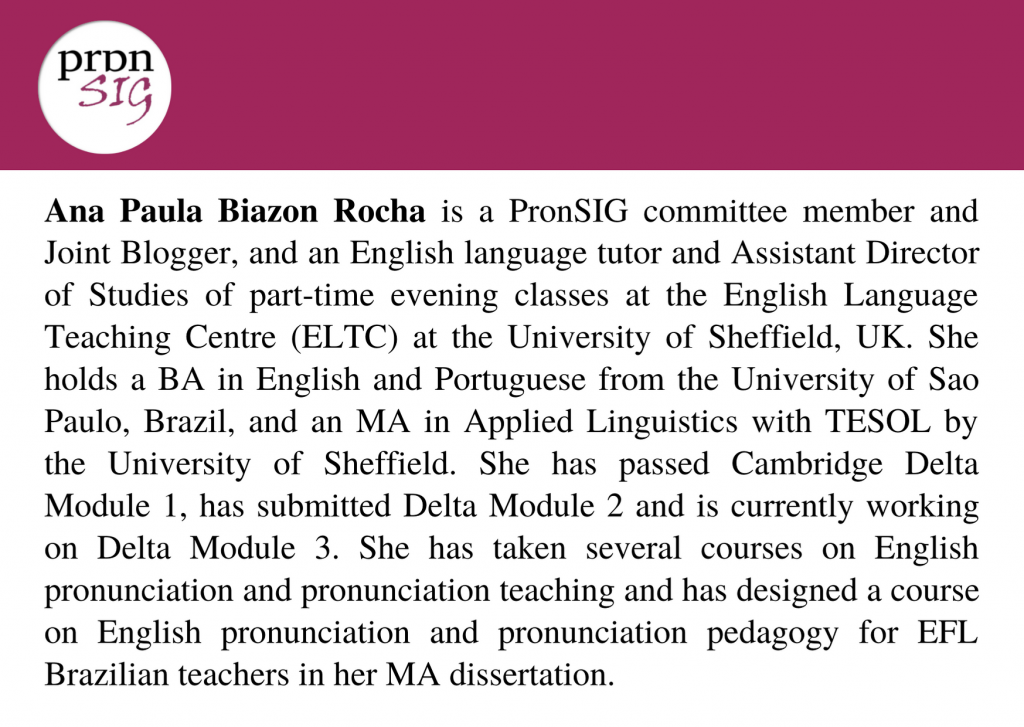by Ana Paula Biazon Rocha
Sometimes we teachers may feel unsure about easy yet effective ways of teaching pronunciation, especially now in these trying times when we have to teach online or in socially distanced classes with (or maybe without) masks on. It is important to keep in mind that mind and body play a key role in pronouncing sounds, and that pronunciation involves a physical aspect (Hancock, 2019; Yoshida, 2016). So why not use our hands to help students ‘visualise’ the articulation of sounds and some pronunciation features?
Terminology-filled descriptions of sound production tend not to be as practical as demonstrating it to students and having them follow you, so that they can learn by doing. In fact, visual demonstrations are one of the first steps introduced in the communicative framework for teaching pronunciation by Celce-Murcia, Brinton and Goodwin (2010). Moreover, we should not forget that we are one of our students’ main pronunciation models (Walker, 2019), therefore we should use our voice and our mouth as a model as well (Yoshida, 2016).
Personally, I don’t mind showing students my mouth, teeth, lips and tongue when demonstrating the production of sounds, they quickly engage because they feel comfortable: ‘If my teacher is doing it, I can do it too!’ However, some teachers may feel uncomfortable opening their mouths to show students how to articulate a sound, especially in front of a webcam; and in face-to-face classes, can we or do we lower our mask or not? Believe me, I’ve been through that!
Thus, here are five simple techniques that involve using your hands to teach pronunciation (sanitised hands, of course!):
1. To show the articulation of consonant sounds such as /l/ and others, you should use your upper hand to represent the top of your mouth and the tip of your fingers to represent the teeth. Your lower hand represents the tongue (Lane, 2010).

2. You can use fists and open hands to represent stressed and unstressed syllables in a word, and then stressed and unstressed words in a sentence (Patsko, 2015).

Similarly, you can also represent word stress by opening your arms on the stressed syllable (Jones, 2019).

3. To introduce the rhythm of English, you and your students can clap hands on the stressed syllables and words, squeezing the unstressed syllables and words among them (Jones, 2019; Yoshida, 2016).

(You can hear the audio of the example above at Yoshida’s (2016) Beyond Repeat After Me website here, chapter 13, sound 13.1.)
4. To introduce voicing, have students place the tip of their fingers on their throat (the Adam’s apple) and ask them to alternate between the consonants sounds /v/ and /f/, so that they can feel their vocal cords vibrating when producing /v/ and not vibrating when producing /f/, that is, voiced and voiceless sounds, respectively (Lane, 2010).

5. To have students ‘visualise’ vowel length, such as the difference between /æ/ in ‘man’ or ‘bad’ and /e/ as in ‘men’ or ‘bed’, I place one finger next to my mouth to represent how it opens for the sound /e/ (less open) and two fingers to represent how the mouth opens for the sound /æ/ (more open). See a demonstration here:
Using hand gestures helps students ‘visualise’ pronunciation and experience it when they follow what you are doing. It also brings a fun element to the lesson as I mentioned, students may feel a bit shy at first, but if you are doing it confidently, they will follow you and have fun with it. After demonstrating, you can have pairs or groups working on the hand gestures themselves to continue practising.
Hopefully, these techniques can be used either online or face-to-face and require no previous preparation or extra materials, they are about teaching pronunciation simply but effectively in any class.
Don’t forget to follow PronSIG on social media and leave your comments below.
References:
Celce-Murcia, M., Brinton, D., & Goodwin, J., with Griner, B. (2010). Teaching pronunciation: A course book and reference guide (Second Edition). New York, NY: Cambridge University Press.
Hancock, M. (2019). “Pronunciation: muscle, mind, meaning, memory”, English Teaching Professional, 22. Available at: http://hancockmcdonald.com/ideas/pronunciation-muscle-mind-meaning-memory
Jones, T. (2019). Fifty ways to teach pronunciation. Tips for ESL/EFL teachers. Wayzgoose Press.
Lane, L. (2010). Tips for teaching pronunciation: a practical approach. White Plains, NY: Pearson Longman.
Patsko, L. (2015). Ten Tips for Teaching Pronunciation. Available at: https://www.cambridge.org/elt/blog/?p=3142?utm_source=cambridgeconversations&utm_medium=blog&utm_content=&utm_campaign=content
Walker, R. (2019). Pronunciation Teaching Basics. IATEFL PronSIG Event, Glasgow: University of Strathclyde. Slides available at: https://pronsig.iatefl.org/wp-content/uploads/2019/Glasgow2019/Walker-Glasgow-2019.pdf
Yoshida, M. T. (2016). Beyond repeat after me. Teaching pronunciation to English Learners. TESOL Press.



Hi Business Ideas UK, I’m glad you enjoyed it, thanks a million! (Ana)